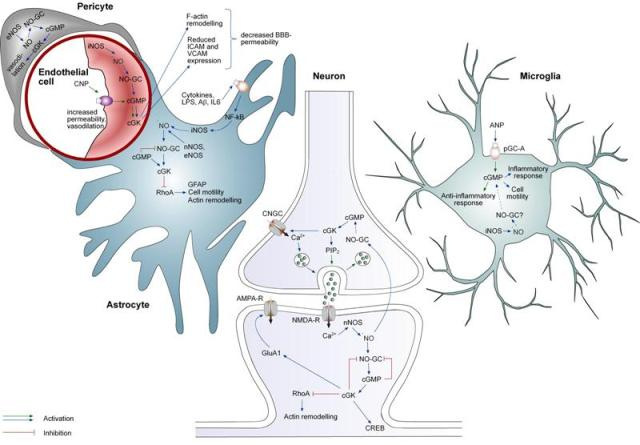The Interplay between cGMP and Calcium Signaling in Alzheimer’s Disease
 Cyclic guanosine monophosphate (cGMP) is a ubiquitous second messenger and a key molecule in many important signaling cascades in the body and brain, including phototransduction, olfaction, vasodilation, and functional hyperemia. Additionally, cGMP is involved in long-term potentiation (LTP), a cellular correlate of learning and memory, and recent studies have identified the cGMP-increasing drug Sildenafil as a potential risk modifier in Alzheimer’s disease (AD). AD development is accompanied by a net increase in the expression of nitric oxide (NO) synthases but a decreased activity of soluble guanylate cyclases, so the exact sign and extent of AD-mediated imbalance remain unclear. Moreover, human patients and mouse models of the disease present with entangled deregulation of both cGMP and Ca2+ signaling, e.g., causing changes in cGMP-mediated Ca2+ release from the intracellular stores as well as Ca2+-mediated cGMP production. Still, the mechanisms governing such interplay are poorly understood. Here, we review the recent data on mechanisms underlying the brain cGMP signaling and its interconnection with Ca2+ signaling. We also discuss the recent evidence stressing the importance of such interplay for normal brain function as well as in Alzheimer’s disease.
Cyclic guanosine monophosphate (cGMP) is a ubiquitous second messenger and a key molecule in many important signaling cascades in the body and brain, including phototransduction, olfaction, vasodilation, and functional hyperemia. Additionally, cGMP is involved in long-term potentiation (LTP), a cellular correlate of learning and memory, and recent studies have identified the cGMP-increasing drug Sildenafil as a potential risk modifier in Alzheimer’s disease (AD). AD development is accompanied by a net increase in the expression of nitric oxide (NO) synthases but a decreased activity of soluble guanylate cyclases, so the exact sign and extent of AD-mediated imbalance remain unclear. Moreover, human patients and mouse models of the disease present with entangled deregulation of both cGMP and Ca2+ signaling, e.g., causing changes in cGMP-mediated Ca2+ release from the intracellular stores as well as Ca2+-mediated cGMP production. Still, the mechanisms governing such interplay are poorly understood. Here, we review the recent data on mechanisms underlying the brain cGMP signaling and its interconnection with Ca2+ signaling. We also discuss the recent evidence stressing the importance of such interplay for normal brain function as well as in Alzheimer’s disease.
read more: https://www.mdpi.com/1422-0067/23/13/7048
- 71 views
